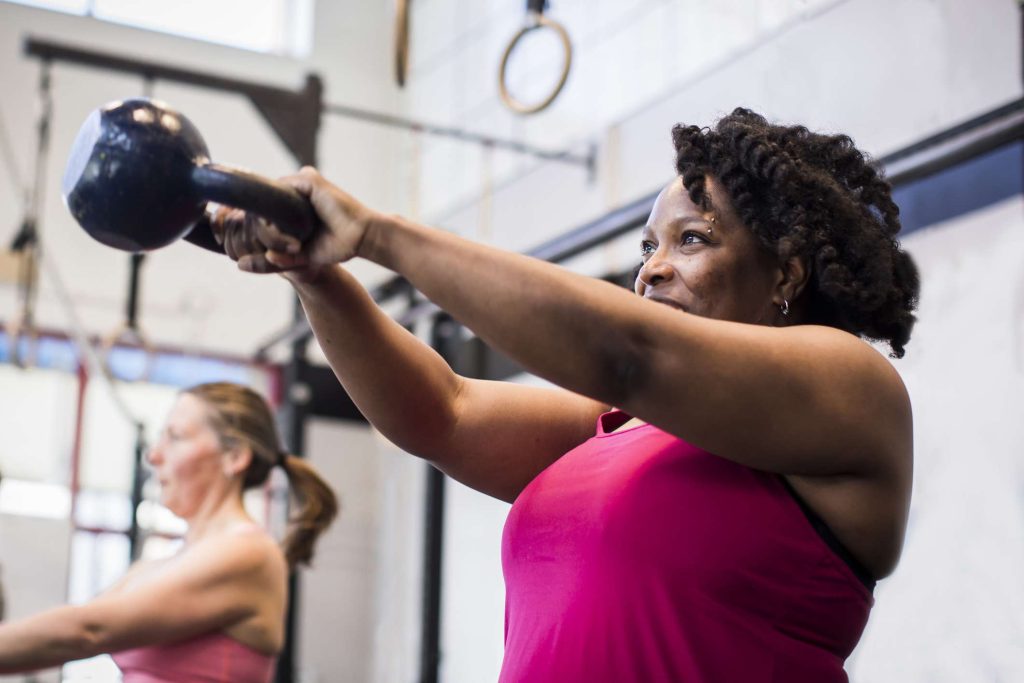:max_bytes(150000):strip_icc():format(jpeg)/health-GettyImages-1255103212-ec5aa352e3274e929683cf652c98b780.jpg)
Menopause is when menstruation stops. This happens when the ovaries reduce their production of the reproductive hormones estrogen and progesterone. Menopause is a natural part of aging and typically occurs between ages 45 and 55 in people who menstruate.
Symptoms can include hot flashes, mood swings, sleep disturbances, and changes in metabolism. Changes like decreased muscle mass and bone mineral density are also common and may lead to complications like sarcopenia (loss of muscle mass and strength) and osteoporosis (weak and brittle bones).
Regular exercise can help manage some of the symptoms of menopause and maintain bone and muscle strength, reducing later health complications.
Regular exercise can be a useful management tool to help improve mood, sleep, metabolism, bone strength, and overall health during menopause.
Supports Weight Management and Metabolism
As estrogen levels drop during menopause, many people experience a slowed metabolism that can lead to weight gain around the midsection. These changes are largely due to estrogen’s metabolic role and ability to affect body composition and fat distribution.
The decrease in estrogen reduces the body’s ability to efficiently burn calories and use fat for energy, resulting in more fat accumulation. This process is compounded by decreased muscle mass during menopause. With less muscle mass, overall calorie-burning capacity drops, making it easier to gain weight even if eating habits and activity levels remain the same.
Another key metabolic role of estrogen is its effect on insulin. When estrogen levels drop during menopause, the body becomes less sensitive to the hormone insulin, which moves glucose (blood sugars) into cells to use for energy. This leads to insulin resistance, where the body’s cells don’t respond to insulin as well, resulting in higher blood sugar levels and increased fat storage.
Exercise directly targets all of these metabolic shifts during menopause. When you exercise, you burn more energy, which leads to less fat accumulation. You also stimulate muscle growth, which increases your energy expenditure and improves your insulin sensitivity, assisting with weight management and metabolic shifts during menopause.
Maintains Bone Mineral Density
Estrogen plays a key role in maintaining bone density, and the drop in estrogen during menopause increases the risk of osteoporosis (bone thinning and weakening) and later bone fractures. Load-bearing exercises, particularly from strength training, are beneficial for maintaining bone health because they stimulate bone formation and also reduce the rate of bone loss, supporting better skeletal health.
Protects Heart Health
The risk of cardiovascular disease increases during menopause and aging. Exercise has several positive effects on heart health, including lowering blood pressure and improving circulation, both of which lower the risk of heart disease. Exercise also indirectly reduces heart disease risk by improving insulin sensitivity and fat deposition.
Improves Sleep Quality
Sleep disturbances like insomnia, night sweats, and hot flashes are common during menopause. Regular physical activity helps regulate body temperature and circadian rhythm (your body’s natural sleep-wake cycle), making it easier to stay cool, fall asleep, and wake up at consistent times.
Exercise also promotes deeper, more restorative sleep cycles by increasing slow-wave sleep (deep sleep) and improving overall sleep efficiency. It also lowers stress hormones, such as cortisol, helping to ease anxiety and promote relaxation.
Supports Emotional Well-Being
Exercise promotes the release of endorphins, which are the body’s natural feel-good hormones. These hormones help reduce anxiety and stress, two factors that often contribute to emotional distress during menopause.
Exercise also helps reduce mood swings and irritability, creating a positive feedback loop where a better mood results in better sleep quality, improved energy levels, and healthier lifestyle choices.
While there are many ways to exercise, two particular types of movement show the greatest results for easing menopausal symptoms. Make sure to talk to your healthcare provider before starting a new exercise routine if you have another health condition.
Strength Training
Decreases in metabolism, bone mineral density, and muscle mass are major concerns during menopause. Exercises geared towards strength and muscle growth can help offset these symptoms.
You can start full-body strength training using bodyweight exercises. Once you have the correct forms down, try implementing free weights to increase your load.
You can also work with a personal trainer to learn foundational movements and weight lifts that target the major muscle groups in your body. Some examples of these movements include the squat, bench press, deadlift, overhead press, lat pull-down, and row.
Low-Moderate Intensity Aerobic Exercise
To target the metabolic and emotional changes common to menopause, implement aerobic exercise, such as dancing, running, biking, or hiking. Aerobic exercise is an activity that uses large muscle groups at the same time, often rhythmically and for longer durations. Research has shown it can improve your insulin sensitivity, sleep quality, and mood.
You can start by choosing a cardio medium of your choice and exercising at a sustained pace that results in labored breathing but doesn’t leave you gasping. Try to maintain a consistent heart rate of around 70% of your maximum heart rate.
If you have a heart condition, talk to your healthcare provider about which type of aerobic exercise is safe and appropriate for you.
Creating an exercise plan is highly personalized to the individual, but you can start with a few basic principles:
- Start with less and build up over time, especially if you’re new to exercise or haven’t done it in a while.
- Aim for an equal balance of strength and cardio. Create a schedule for which days of the week you’ll do which exercises.
- Be consistent. It may take time to see improvements in your symptoms, so keep up a regular exercise routine.
To structure a strength workout, choose a handful of strength exercises (5-6) targeted at different muscle groups and complete 8-12 reps of each movement. Make sure to leave a little extra energy in the tank during each set to ensure your form stays perfect. Start with one day of strength training and gradually build up more days, more exercises, and heavier weights, also known as progressive overload.
For your cardio workouts, similar principles apply. Start with one day of cardio and gradually build up to more days with a longer duration. Depending on your current aerobic capacity, you can start with 5-10 minutes of exercise and gradually work up to 60 minutes several times per week.
While exercising to reduce menopause symptoms, it’s important to listen to your body. Keep exercise intensity manageable, and choose exercises that allow you to move without pain. One of the biggest culprits for injury is doing too much, too quickly, or ignoring pain signals. If you need help designing a program, don’t hesitate to reach out to a fitness professional for help.
Menopause is a natural part of aging for people who menstruate. While some menopause symptoms can disrupt your daily life, you can manage many symptoms with the right lifestyle changes. Exercise can help improve mood, sleep, metabolism, bone strength, and overall health during menopause.
Strength training and aerobic exercises like dancing, running, or hiking have been shown to be especially helpful for reducing menopausal symptoms. Implement these exercises into your routine gradually, and talk to a fitness professional if you need help designing a routine.








